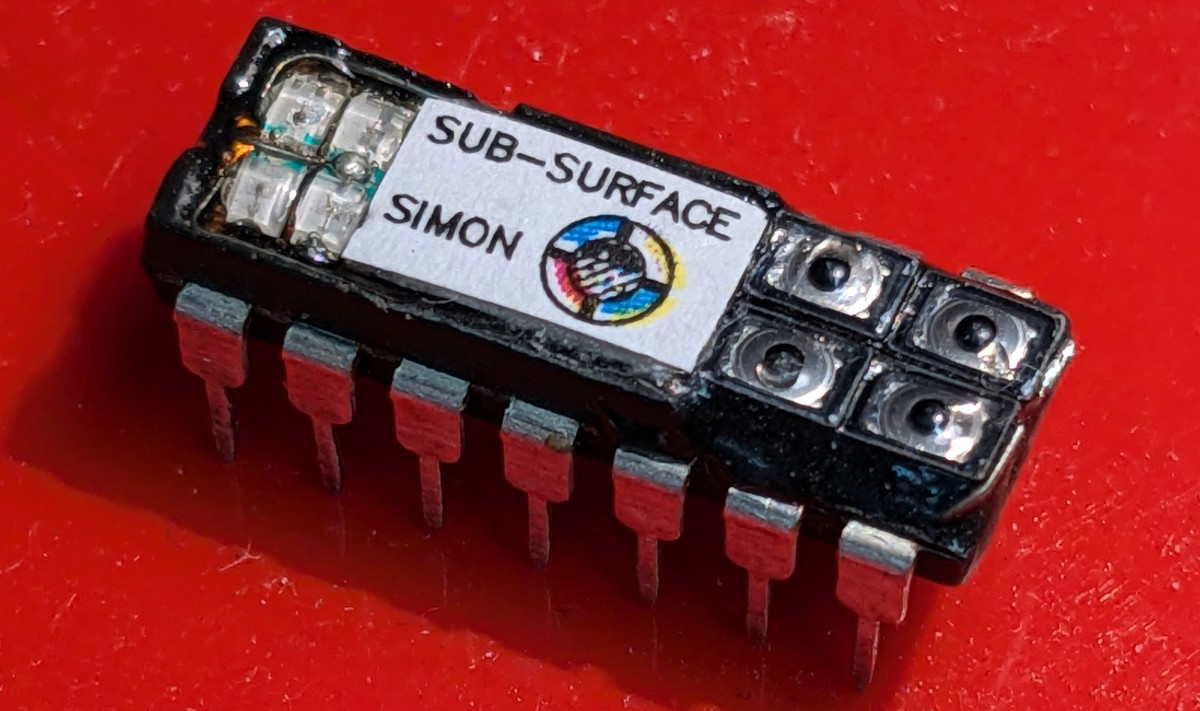Over the years, we’ve figured out some pretty sure-fire ways to get hackers and makers motivated for contests. One of the best ways is to put arbitrary limits on different aspects of the project, such as how large it can be or how many power it can consume. Don’t believe us? Then just take a look at the entries of this year’s Tiny Games Contest.
Nearly 80 projects made it across the finish line this time, and our panel of judges have spent the last week or so going over each one to try and narrow it down to a handful of winners. We’ll start things off with the top three projects, each of which will be awarded a $150 gift certificate from our friends at DigiKey.
First: Sub-Surface Simon

While this contest saw a lot of excellent entries, we don’t think anyone is going to be surprised to see this one take the top spot. Earning an exceptionally rare perfect ten score from each of our judges, Sub-Surface Simon from [alnwlsn] grabbed onto the theme of this contest and ran like hell with it.
Exploiting the fact that many integrated circuits are actually far smaller than their external packages, [alnwlsn] milled away the inert plastic surrounding the DIP-14 version of the ATtiny84A, which left just enough room to install some LEDs and buttons. This means the complete game is housed within the boundaries of the chip itself — just plug it into a powered breadboard and get playing.
Second: Morse Quest

Coming in at second place is Morse Quest, from [felix]. Basically, [felix] took the classic text-based adventure game formula, and replaced the keyboard and monitor with a microswitch and an LED. Players not only need to correctly decode the flashing LED to figure out what the game is saying about their immediate environment, but they have to compose their response and key it in manually.
Always wanted to learn Morse code, but didn’t know how to get started? Well, this game probably isn’t it. While you can select the rate at which the same blinks out the game to make things a little easier on yourself, you’ll still need a pretty solid knowledge of Morse to explore very far.
Third: WS2812B Othello

Easily the most traditional game of the of the top three, this handheld Othello allows the player to challenge a computerized opponent on an 8×8 matrix of WS2812B LEDs. As the LED board is an off-the-shelf module, [Dave] was able to hide most of the main PCB’s electronics underneath it, giving the overall device a particularly clean look.
As nice as the hardware is, the software is equally impressive. Running on an 80 MHz STM32L412KBT6, [Dave] wrote the entire firmware without using any external libraries. Most of us would have been reaching for a common library just to get the hardware working, but he wrote everything from the button debounce routines to the actual logic by which the game is played.
Honorable Mentions
There’s no way we can pick just three of these incredible projects to showcase, so as usual, we have a few additional categories for entries that really stood out to the judges.
One Dimensional: For this category we wanted to get people thinking about what they could do with a common addressable LED strip, and T1Duino from [Andrea Trentini] didn’t disappoint. This large-format game re-imagines Tetris in a single dimension by focusing on the colors of the falling blocks instead of their shapes. But we’ve also got to give credit to [senily64dx], who really thumbed their nose at this one. Zero Dimensional PONG recreates the classic game with just a single LED. The players are meant to interpret the changing brightness of the LED as it moving closer or farther away from them, and time their button presses accordingly.
The Classics: This category was devoted to entries that brought back the iconic games of yesteryear, so it’s little surprise that the judges singled out this miniature Space Invaders arcade cabinet from [Nick Cranch] as a prime example. Just one classic game not enough? Then take a look at the μRetro from [bobricius]. This gorgeous handheld uses ATtiny85 cartridges that let’s you swap between a collection of arcade standards.
The Controls: Nintendo has spent the last couple of decades proving that how players interact with the hardware can be just as important as the games themselves, and these entries are no different. Salsa ONE by [Alex] is a minimalistic handheld that you play with just a single button, while Blind Maze from [penumbriel] tasks the player with navigating an invisible maze using an interface consisting of a trio of buttons and LEDs.
Pocket Arcade: Each judge agreed that, as far as being pocket-friendly, the Wibraboy was the project to beat. By repurposing the enclosure from a cheapo handheld game, [x3e] was able to give their DIY recreation a remarkably professional look. For those with even smaller pockets, the Tiny OLED by [deʃhipu] offers up classic gameplay in an exceptionally small footprint.
Fancy!: Finally, this category was devoted to the most polished and professional looking builds. Among all the projects, the LED Matrix Arcade from [Ryan Shill] may be the most attractive of the bunch. With its vibrant 32×32 LED array and walnut enclosure, it’s a build we’d be proud to have on display at home. The all-digital Mini Virtual Pinball Cabinet created by [mircemk] was also a favorite for this category, as it does an excellent job of recreating the authentic pinball look with a sideways-mounted 17 inch monitor.


Shall We Play a Game?
There’s only so many projects we can call out individually, so we strongly recommend you head over to Hackaday.io and browse all of the incredible entries into this contest. There’s some truly impressive work in there, and we’re willing to bet you’ll find something in there that will help inspire your own projects.
We’d like to thank DigiKey for helping to make this contest possible, and of course the Hackaday community for consistently rising to our latest challenge. Speaking of which, you’ve still got some time before the deadline to submit your best Simple Supercon Add-On for our latest contest.
